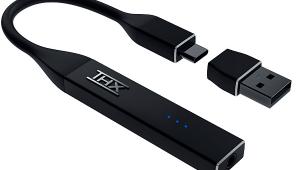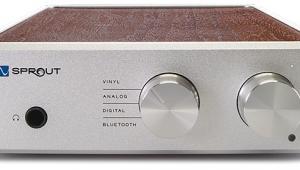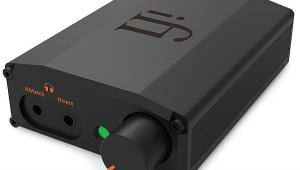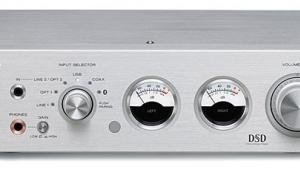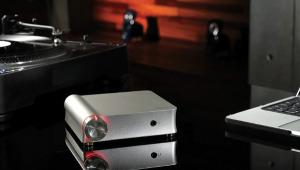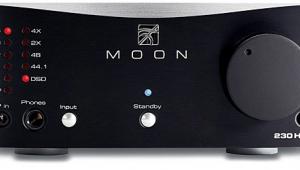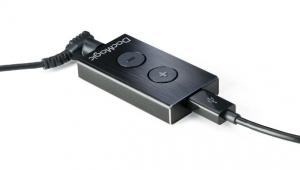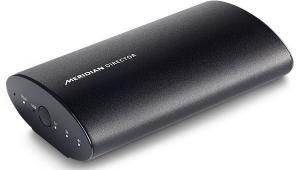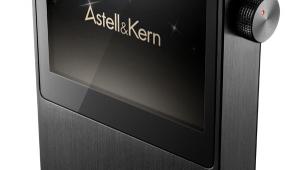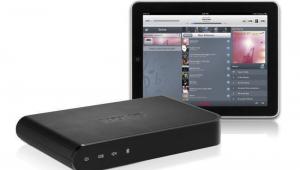Review: FiiO E10, HRT HeadStreamer, and NuForce uDAC-2SE USB DAC/Headphone Amplifiers Page 4
FiiO E10
($80, fiio.com.cn)
We looked previously at FiiO's impressively full-featured E17 (along with its companion piece, the E9 desktop headphone amp). The E10 is a rather different beast; a tiny, minimal, USB-input-only DAC/headphone amp, meant (like the HeadStreamer) for use with a desktop computer. Like the HRT, the E10 is 24/96 compatible; unlike it, it's got a S/PDIF output so you can also use it as a digital format converter to drive another DAC, there's a handy fixed-level analog line out (on 1/8-inch minijack, like the headphone output) and it includes a nice little analog volume pot. There's even a high-low gain switch, as well as a switchable bass boost should you be the sort of person who likes that kind of thing. Basically, it's more of the usual from FiiO - a ton of features and pretty good performance to boot, for very little money
At this price, something has to give, and here it is: Unlike the NuForce and HRT units discussed here, the E10 doesn't use asynchronous USB transfer mode, relying instead on a good old adaptive mode connection. As we said up top, adaptive mode continues to be used in many well-thought of (and even reference-class) devices, so this absolutely shouldn't be cause to dismiss a sub-$80 DAC/amp.
Especially one that sounds as satisfying as this little guy does. To my ear, the E10's a bit warmer sounding than either the HRT or NuForce unit - even without the bass boost engaged (more on that in a second). That said, it's tight in the low end, and smooth on up the frequency spectrum, though perhaps with a little less overall clarity than the NuForce. It's a nice sound for rock and pop music, and if you're looking for extra kick for headphones that already do OK with your computer, this may be enough upgrade for you.
I did find myself needing to switch over to the high gain setting to get good levels out of the Sennheiser HD-650 and both sets of HiFiMan planar magnetic headphones; this made things just a tiny bit more hissy than I'd prefer (listening to Marianne Thorsen and the Trondheim Soloists' recording of Mozart's Violin Concerto no. 4 in D major, for example, there was a bit of haze around the end of unaccompanied violin passages), but the unit is plenty usable for most material. Still, if you're doing a lot of listening to music with quiet passages and you have difficult to drive headphones, you may just need a little more horsepower than the E10 can provide. And the E10 is, mind you, very impressive for the price.
The bass boost toggle is, to my ear, overly broad and boomy (the idea is much better implemented on the more expensive E17, with its adjustable bass and treble controls), and with any sort of dense music in can make things boomy and cluttered rather quickly, especially if you're using the E10 at the high-gain setting. I preferred it in the off position in almost all cases - generally, bass boost seems more useful to me as a feature for out-and-about use. Still, it does have its adherents - and in particular it could see it making a nice complement to noise cancelling headphones, so perhaps it'd be a nice feature if you're using the E10 with such cans to provide music in an office setting.
As some other reviewers have reported, the minijack used on this unit isn't of the most secure design, and when used with headphones with heavier jacks (think a 1/4-inch termination with a 1/8-in adapter, we had some intermittent slippage (the E10 is small and lightweight enough that a thick headphone cable will drag it around your desk). Given the otherwise quite impressive fit and finish of the unit, this is a tad disappointing, though with more minimally cabled headphones you likely won't run into problems. Still, this is enough to be annoying, and hopefully it'll be corrected in future updates to the unit.
Bottom Line
If you're curious about upgrading your digital audio setup - say you've picked up a pair of quality headphones recently, and you're finding that the onboard amp in your PC isn't cutting it - there's probably never been a better time to be in the market for a little DAC/headphone amplifier combo. There are dozens and dozens of units available for even the tightest of budgets, with the three units we've just looked at represent some quality choices at a few likely price points. The HRT's a great value if you're comfortable with its software volume control and don't think you'll need a line output or forsee a need to interface with an external DAC.
Should you be interested in something slightly more flexible, the choice between the FiiO and NuForce units is a bit more difficult. The E10 is certainly a good value at it's price point, and featurewise the two devices stack up quite similarly. Sonically I'd give the uDAC-2SE a slight edge - it's a bit cleaner and more refined, but it does cost almost three times as much, and the E10 is a very good sounding unit in its own right (and there are probably headphones that would be well served by the bass boost). Another thing to keep in mind - the E10's fixed-level line out might make sense if you're looking to add a DAC to an older receiver, while the uDAC-2SE, with its variable preamp output, would make a better front end for a desktop system that includes a pair of active speakers. You'll really want to listen to both, I'd say.
And in closing, a portable high-rez geek note: The original uDAC-2 was problematic for me in use with the iPad - sometimes it was recognized, more often than not it was rejected. Obviously I can't blame the device, since it wasn't really designed for that application. Interestingly enough, however, the SE worked with my iPad2/Camera Connector Kit/Tekkeon in-line USB power supply setup from the first try, so as a multipurpose device it's definitely worth a shot if you're the kind of person who could use a mobile high-rez playback option.
I couldn't get either the FiiO or the HeadStreamer working with an iPad and Camera Connector Kit, though others have reported success with the HRT device - and if it did work, this is one situation I in which I could see the volume control paradigm making a lot of sense, since you'd never have to reach into your pocket or bag to adjust output levels while using your iPad (the touchscreen is tactile enough for anybody's needs).
